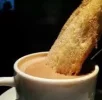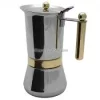Mike Savage
So many friends to meet . . . so little time
- Time of past OR future Camino
- Camino Francés,Inglés
Muxia/Finisterre
Português Coastal
Português Central
Sanabrés
I really enjoyed the coffee on my caminos and am wondering how I could duplicate it at home. I don't have an extensive knowledge of coffee so maybe it is already available but I don't know what it is called.
Here in the states I drink plain black coffee that comes preground in a large can. My wife likes roast coffee and grinds her own beans; this tastes "burnt" to me and I don't care for it. In Spain I would drink solo or Americano with no sugar or milk. This tasted strong but good and no "burnt" taste. This is what I would like to make at home. Maybe I need a special machine or beans or both?
Any and all suggestions are appreciated.
Mike
Here in the states I drink plain black coffee that comes preground in a large can. My wife likes roast coffee and grinds her own beans; this tastes "burnt" to me and I don't care for it. In Spain I would drink solo or Americano with no sugar or milk. This tasted strong but good and no "burnt" taste. This is what I would like to make at home. Maybe I need a special machine or beans or both?
Any and all suggestions are appreciated.
Mike




















